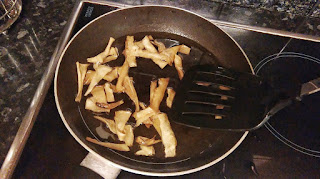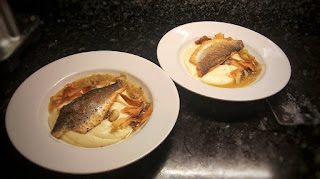Are you tired of eating chicken week in, week-out?
Guinea fowl is available all year round and is a great alternative to chicken, with a taste learning towards pheasant. Excellent simply roasted with your usual Sunday lunch trimmings, or you can mix things up with this Asian influenced recipe.
As guinea fowl is slightly drier than chicken, marinating the bird before cooking helps to tenderise the meat and keep it moist. I used this simple WomanandHome asian influenced marinade.
This dish turned out to be lots of firsts for me. First time spatchcocking a bird. First time using lemon grass, and first time using pak choi.
If you’re also a spatchcock newbie, I’d recommend taking a look at this simple 2 minute video from the BBC before attempting anything. Then arm yourself with a good pair of kitchen scissors and a sharp knife. If you have the right tools the process is very simple. My knife however was slightly blunt so at times it turned into a bit of a hackathon, but I won in the end!
Tip: Don't discard the backbone, it'll be great in a stock!
As for lemongrass, I learned a few things about this also – whole lemongrass can be used in stews and curries (removed before eating), or chopped and used in marinades, which is what we’re going to do here. Again, a sharp knife helps as the woody stalk can be difficult to cut through with a blunt one… (I think what I need to take away from this experience is to buy new knives!).
We’re also welcoming pak choi to the family! I’ve eaten it several times at Asian restaurants but never prepared myself. It can be stir fried in a few minutes so it was a no fuss addition to the noodles , providing a burst of vitamic C, A and fibre.
Serves 2
You’ll need:
1 guinea fowl, spatchcocked and cut into 4 pieces
For the marinade
1 tablespoon fish sauce
1 tablespoon light soy sauce
2 teapsoon sesame seed oil
2 tablespoon groundnut oil
1 lime; zest and juice
2 sticks lemongrass
1 tablespoon chilli sauce
2 garlic cloves, peeled and chopped
2 inch piece of fresh ginger, peeled and chopped
1 green chilli, roughly chopped
Black pepper
For the noodles
2 nests of noodles (rice, udon work well)
1 tablespoon olive oil
1 tablespoon fish sauce
2 tablespoons light soy sauce
1 tablespoon dark soy sauce
1 red chilli, sliced
2 garlic cloves, chopped
small bunch of spring onions, sliced
4 small pak choi, leaves separated
To serve
1 lime, halved
Method:
Once you’ve mastered cutting up your guinea fowl into 4 pieces, place them in a bowl.
Mix together the marinade ingredients and pour over the guinea fowl, ensuring to mix well so all the meat is coated. Cover with cling film and place in the fridge for at least 3 hours, or overnight.
Preheat the oven to 180 degrees c / 350 degrees f
Heat a frying pan with a little olive oil and sear the guinea fowl skin side down for a couple of minutes.
Place in a small roasting tin and put in the oven for 40 mins until cooked.
Remove and leave to rest for 10 mins.
Just before the guinea fowl is done, cook your noodles in a pan of lightly salted, boiling water.
Re-heat the frying pan you used to sear the guinea fowl, adding a little extra olive oil if needed.
Add the chilli and garlic and fry for a couple of minutes, then add the spring onions and pak choi leaves.
Cook for a few minutes, allowing the pak choi to wilt down.
Once the noodles are cooked and drained, add to the pan along with the sauces and stir fry for a couple of minutes, ensuring the ingredients are evenly coated.
To serve, put the noodles in a circular shape on the plate and place the
guinea fowl pieces on top. Squeeze fresh lime juice over the meat to
taste.
Wednesday, 24 February 2016
Tuesday, 2 February 2016
Sea bass with parsnip purée and parsnip crisps
Looking for something a little extra to cook on a Friday night in, we settled on this Michel Roux recipe as published on BBC goodfood. I’m not usually a massive parsnip fan, but this parsnip loaded dish is de-licious! Crunchy parsnip crisps contrast with the creamy parsnip purée, complementing the crispy skin and tender flesh of the sea bass.
In any Michel Roux recipe there’s usually at least one ingredient I don’t have in the cupboard or can’t easily buy in a local store– this time it was veal stock which I switched out for chicken stock. I also didn’t have the fish bones as my sea bass was already filleted, so simply left these out of the method (although I’d advise you to include for depth of flavour if you have them).
My adjusted/simplified version with a couple of tweaks is below. I’ve also removed the caramelised garlic and shallots – my personal preference is against large chunks of shallot/garlic on my plate, no matter how caramelised, and Michel’s method of boiling for 2 minutes, draining and repeating 4 times is a little too tedious for me.
You’ll need:
Olive oil
2 fillets of sea bass
2 shallots, sliced
40g button mushrooms, sliced
½ tbsp white wine vinegar
200ml chicken stock
½ tbsp butter
For the parsnip purée:
2 ½ parsnips
60ml milk
½ tbsp butter
For the parsnip crisps:
½ parsnip
Oil for deep drying (sunflower)
For the the parsnip crisps:
Peel the parsnips and then use a vegetable peeler to slice as thinly as possible.
Heat enough oil (a couple of centimetres) in a saucepan to allow you to deep fry the strips of parsnip until very hot.
Drop the parsnips into the hot oil until lightly browned (they will crisp up more once you take them out of the oil).
Remove from oil with a slotted spoon and drain on kitchen towels to absorb the excess fat.
Depending on the size of your frying pan you may need to do this in batches – you only want a single layer of parsnips at a time in the hot oil. Set aside in a dry place until required – you can make up to a day ahead, stored in an air tight container.
For the parsnip purée:
Peel the parsnips and cut into big chunks. Drop into a saucepan of salted, boiling water until tender – about 20 mins.
Drain well, then put in a blender with the butter and some of the milk and blend until smooth: you’re aiming for the consistency of double cream so add more milk as necessary. Season to taste.
For the sauce:
Heat a little olive oil in a saucepan and cook the sliced shallots for 5 mins until softened and golden.
Add the mushrooms and cook for a further 10 mins, stirring occasionally. Add the vinegar and bring to the boil for 3 mins. Now add the stock, season lightly and simmer for 30 mins.
(At this stage Michel advises you to pass the sauce through a fine sieve into a clean pan. I wanted to keep the shallot/mushroom mixture though so I skipped this step.)
Whisk in the butter to thicken.
For the seabass:
Score the skin of the fish with a sharp knife – to help prevent curling during cooking. Season with salt and pepper
Add a few drops of olive oil to a frying pan and heat until shimmering and very hot. Then add the fish, skin side down. Press down on the fish with a spatula if it begins to curl up.
Once the skin is browned (should take around 5 mins), turn the fillets over and cook the other side for a further 1 – 2 mins (timings dependant on the thickness of your fillets).
To serve:
Re-heat the puree if required and spoon on to warmed plates.
Pour the sauce around the purée and place the fish on top.
To complete, sprinkle over a few parsnip chips as a deliciously unhealthy garnish.
Subscribe to:
Comments (Atom)

















